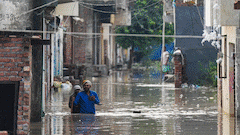Delhi Govt On High Alert After Over 2 Lakh Cusecs Of Water Released From Hathnikund Into Yamuna: Atishi
Delhi Minister Atishi said that the discharge of more than 2 lakh cusecs of water from the Hathnikund Barrage into the Yamuna has sparked concern, prompting the government to take proactive measures.

Revenue Minister Atishi on Saturday said that the Delhi government is on high alert after the discharge of over 2 lakh cusecs of water from the Hathnikund Barrage into the Yamuna. Some parts of Yamuna Khadar (floodplains) might get inundated if the water level in the river rises to 206.7 metres but the government is ready for evacuation, she informed in a statement, as per news agency PTI. According to Central Water Commission (CWC), the flow rate at the Yamunanagar-located Hathnikund Barrage crossed the 1 lakh-mark at 9 am and oscillated between 2 lakh and 2.5 lakh cusecs between 10 am and 4 pm.
The India Meteorological Department has forecast heavy to very heavy rain in parts of Himachal Pradesh and Uttarakhand till July 25.
The Delhi Revenue Minister said that a regular 'munadi' (announcement) is being done in vulnerable areas to inform residents about the risk of flooding. Relief camps have been inspected and preparations made for people to stay there. The Delhi government is on high alert due to the discharge of more than 2 lakh cusecs of water from the Hathnikund Barrage into the Yamuna River, the minister said, as per PTI.
"The situation has sparked concern, prompting the government to take proactive measures to ensure the safety and well-being of the residents," she added.
Chief Minister Arvind Kejriwal has been closely monitoring the situation and overseeing the response efforts, the minister stated.
She further mentioned that the Department of Revenue is taking extensive measures to tackle the situation effectively.
"Whether it's the Central district, Eastern district or areas like Yamuna Bazar and Yamuna Khadar, we have made sufficient preparations to address any challenges that may arise," she said, as quoted by PTI.
The Delhi government has appealed to the public to remain vigilant and cooperate with the authorities during this critical time. Updates and advisories will be regularly provided to keep the residents informed about the evolving situation, Atishi stated.
ALSO READ | 'Surprising': Waqf Board On Railway's Encroachment Notice To 2 Delhi Mosques, Claims As Own Property
Yamuna Water Level Crossed Danger Mark Of 205.33 Metres In Delhi Again
The water level of the Yamuna River in Delhi crossed the danger mark of 205.33 metres yet again on Friday, threatening to delay rehabilitation efforts in the flood-affected low-lying areas. The CWC data informed that the water level reached 205.34 metres at 6 pm yesterday.
In case of heavy rains upstream of Delhi, the increase in the water level threatens to slow down the pace of rehabilitation of the affected families in the inundated low-lying areas of the capital and people may have to stay in relief camps for more days.
It also poses a danger to the water supply in the national capital which became normal only on Tuesday after being affected for four to five days due to the inundation of a pump house at Wazirabad.
The pump house supplies raw water to Wazirabad, Chandrawal and Okhla water treatment plants, which together account for around 25 per cent of the city's supply.
Parts of Delhi have been witnessing waterlogging and flooding for over a week after a downpour caused intense waterlogging on July 8 and 9, with the city receiving 125 per cent of its monthly rainfall quota in just two days.
Then heavy rains in the upper catchment areas of the Yamuna, including in Himachal Pradesh, Uttarakhand and Haryana, led to the river swelling to record levels.
On July 13, the Yamuna surpassed its previous record of 207.49 metres set in September 1978 by a significant margin as the water level reached 208.66 metres. It breached the embankments and penetrated deeper into the city causing more than 27,000 people to be evacuated from their homes. The losses incurred in terms of property, businesses and earnings cost crores.






































